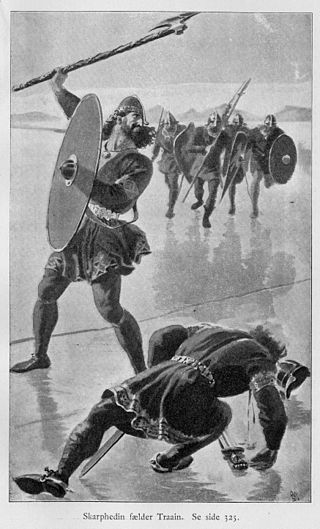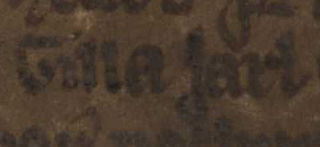
Brian Boru was the High King of Ireland from 1002–1014. He ended the domination of the High Kingship of Ireland by the Uí Néill, and is likely responsible for ending Viking invasions of Ireland. Brian Boru is mentioned in the Annals of Inisfallen and in Chronicon Scotorum as "Brian mac Cennétig". The name Brian of Bóruma or Brian Boru was given to him posthumously Brian built on the achievements of his father, Cennétig mac Lorcain, and especially his elder brother, Mathgamain. Brian first made himself king of Munster, then subjugated Leinster, eventually becoming High King of Ireland. He was the founder of the O'Brien dynasty, and is widely regarded as one of the most successful and unifying monarchs in medieval Ireland.

Njáls saga, also Njála ( ), or Brennu-Njáls saga ( ), is a thirteenth-century Icelandic saga that describes events between 960 and 1020.

The Battle of Clontarf took place on 23 April 1014 at Clontarf, near Dublin, on the east coast of Ireland. It pitted an army led by Brian Boru, High King of Ireland, against a Norse-Irish alliance comprising the forces of Sigtrygg Silkbeard, King of Dublin; Máel Mórda mac Murchada, King of Leinster; and a Viking army from abroad led by Sigurd of Orkney and Brodir of Mann. It lasted from sunrise to sunset, and ended in a rout of the Viking and Leinster armies.
Darraðarljóð is a skaldic poem in Old Norse found in chapter 157 of Njáls saga. It consists of 11 stanzas recounting the vision of a man named Dörruð, in which twelve valkyries weave and choose who is to be slain at the Battle of Clontarf. Their loom uses human entrails as warp and woof, swords as treadles, an arrow as the batten and men's heads as weights. Of the twelve valkyries weaving, six of their names are given: Hildr, Hjörþrimul, Sanngriðr, Svipul, Guðr, and Göndul. Stanza 9 of the song has been translated:
Gormlaith ingen Murchada, sometimes spelt Gormflaith, was an Irish queen.
Thorfinn Sigurdsson, also known as Thorfinn the Mighty, was an 11th-century Jarl of Orkney. He was the youngest of five sons of Jarl Sigurd Hlodvirsson and the only one resulting from Sigurd's marriage to a daughter of Malcolm II of Scotland. He ruled alone as jarl for about a third of the time that he held the title and jointly with one or more of his brothers or with his nephew Rögnvald Brusason for the remainder. Thorfinn married Ingibiorg Finnsdottir, daughter of Finn Arnesson, Jarl of Halland.
Sigurd Hlodvirsson, popularly known as Sigurd the Stout from the Old Norse Sigurðr digri, was an Earl of Orkney. The main sources for his life are the Norse Sagas, which were first written down some two centuries or more after his death. These engaging stories must therefore be treated with caution rather than as reliable historical documents.
Bróðir and Óspak of Man were two Danish or Norwegian brothers who were active in the Isle of Man and Ireland in the 11th century. They are mentioned in the 12th century Irish Cogadh Gaedhil re Gallaibh and the 13th century Icelandic Njal's Saga as the key leaders who fought on opposite sides in the Battle of Clontarf, in 1014. The latter account names Bróðir as the killer of Brian Boru, the High King of Ireland. Both Boru and Bróðir died in the battle, although accounts differ as to who killed whom. Óspak fought on the side of Boru, was injured, and lost his two sons in the battle.
Sigtrygg II Silkbeard Olafsson was a Hiberno-Norse king of Dublin of the Uí Ímair dynasty. He was caught up in the abortive Leinster revolt of 999–1000, after which he was forced to submit to the King of Munster, Brian Boru. His family also conducted a double-marriage alliance with Boru, although he later realigned himself with the main leaders of the Leinster revolt of 1012–1014. He has a prominent role in the 12th-century Irish medieval text Cogadh Gaedhil re Gallaibh and the 13th-century Icelandic Njal's Saga, as the main Norse leader at the Battle of Clontarf (1014).
Brusi Sigurdsson was one of Sigurd Hlodvirsson's four sons. He was joint Earl of Orkney from 1014. His life is recorded in the Orkneyinga Saga.
Sumarlidi Sigurdsson was jointly Earl of Orkney with his brothers Brusi and Einar Wry-Mouth following the death of their father, Sigurd Hlodvisson at the battle of Clontarf. Their half-brother, Thorfinn, was at that time very young, perhaps only five years old, and he was sent to be fostered by his grandfather, King Malcolm II.
Úlfr Uggason was an Icelandic skald who lived in the last part of the tenth century.

Cogad Gáedel re Gallaib is a medieval Irish text that tells of the depredations of the Vikings and Uí Ímair dynasty in Ireland and the Irish king Brian Boru's great war against them, beginning with the Battle of Sulcoit in 967 and culminating in the Battle of Clontarf in 1014, in which Brian was slain but his forces were victorious. The chronicle, which compares King Brian to Augustus and Alexander the Great, was written in the early twelfth century, at least a hundred years after the events it describes. Much of the narrative is drawn from the earlier Annals of Ulster.
Þorsteins saga Síðu-Hallssonar is one of the sagas of Icelanders from the 13th century. The saga is only partially preserved and features a number of dreams and interpretations. Torstein Side-Hallsson has a series adventures in the Orkney Islands, Ireland, Norway and Iceland during the early 1000s. The story also tells of Torstein participating in the Battle of Clontarf in 1014.

Kári Sölmundarson was a Hebridean viking and soldier of fortune who lived in the late tenth and early eleventh centuries. He is a major character in Njál's Saga. Kári was the son of Solmund, who was the son of Thorbjorn "Jarl's Champion," an Icelander exiled before the establishment of the Althing for murder.

Donnchadh mac Briain, son of Brian Bóruma and Gormflaith ingen Murchada, was King of Munster.

Gilli was an eleventh-century Hebridean chieftain whose career coincided with an era of Orcadian overlordship in the Kingdom of the Isles. According to mediaeval saga-tradition, Gilli was a brother-in-law of Sigurðr Hlǫðvisson, Earl of Orkney, having married the latter's sister Hvarflǫð. Traditionally regarded as one of the most powerful Orcadian earls, Sigurðr appears to have extended his authority into the Isles in the late tenth century. Gilli apparently acted as Sigurðr's viceroy or tributary earl in the region. The time frame of Gilli's apparent authority in the Isles is uncertain, and may date as early as the reign of Guðrøðr Haraldsson, King of the Isles, or as late as the period following the death of this man's eventual successor, Rǫgnvaldr Guðrøðarson, King of the Isles. Gilli's name is probably Gaelic in origin, and he seems to have seated himself on either Coll or Colonsay, islands in the Inner Hebrides. It is possible that Gilli is identical to Gilla Ciaráin mac Glún Iairn, an Uí Ímair dynast who was slain at the Battle of Clontarf in 1014. If not, another possibility is that he was the father of a certain Conamal/Conmáel who was killed in 980.
Rusla, also known as the "Red Woman" from Middle Irish Ingean Ruagh, was a legendary Norwegian shield-maiden mentioned in the Gesta Danorum or "History of the Danes" of Saxo Grammaticus and in the Irish annals. According to Saxo, Rusla was the daughter of a fifth or sixth century king of Telemark called Rieg, and sister of Tesandus (Thrond), who was dispossessed of his throne by a Danish king named Omund. Rusla formed a pirate fleet to attack all Danish ships as revenge for the affront to her brother. Rusla was always accompanied by another woman, Stikla, who was her deputy in all raids. Stikla turned to piracy to avoid marriage, and her name is the origin of the Norwegian city of Stiklestad.
The Cairn on the Headland is a short story by American writer Robert E. Howard, with elements of fantasy and horror. As often in Howard stories, there is a link to the Cthulhu Mythos, in this case mixed also with elements of both Norse Mythology and Catholic Christianity.
Domnall mac Eimín meic Cainnig was an eleventh-century Mormaer of Mar. He is attested by numerous accounts of the Battle of Clontarf in which he is said to have lost his life supporting the cause of Brian Bóruma mac Cennétig, High King of Ireland, a king whose forces fought against those of Sitriuc mac Amlaíb, King of Dublin, Máel Mórda mac Murchada, King of Leinster and Sigurðr Hlǫðvisson, Earl of Orkney. Domnall is the first Mormaer of Mar on record, and the Irish sources that note him are the earliest sources to note the province of Mar. Domnall is the only Scottish combatant recorded to have in the Battle of Clontarf. His motivations for fighting are uncertain.





